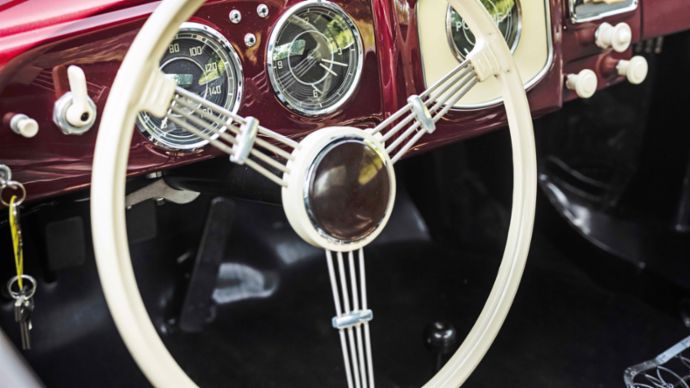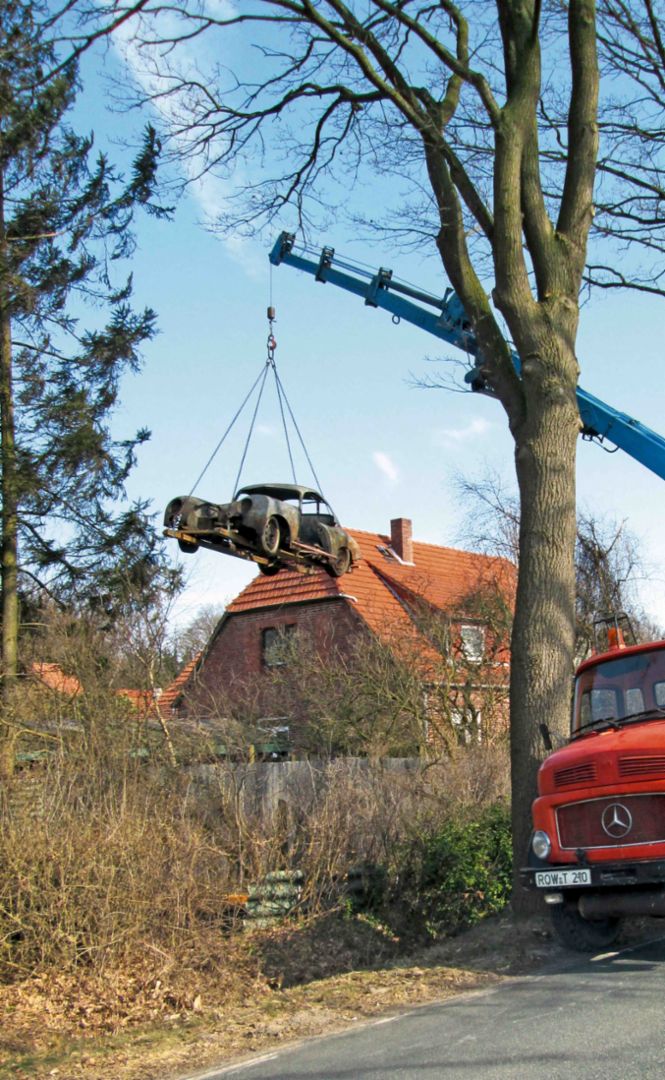



Its rescue story begins in January 2013 when König and Schmidt receive a phone call. The caller begins by inquiring whether it is true that the oldest Porsche 356 produced in Germany and still in existence, number 5047, is on display in Hamburg. Upon this being confirmed, the man cuts to the chase – he claims to have an older model bearing chassis number 5006. And he is willing to sell.
The Automuseum Prototyp in Hamburg has had partnership ties with the Porsche Museum in Stuttgart-Zuffenhausen for some time. Its two founders have spent decades collecting, focusing in particular on early Porsche constructions. “We were instantly electrified – but also skeptical,” Schmidt reminisces. “Many calls like that lead only to disappointment.”
Their skepticism evaporates when the first photos arrive. One of them shows the four digits 5006 hammered into the sheet metal, while another features a weathered data plate – likewise bearing the number 5006 – alongside red paint residues. It would appear that the car is outdoors, more or less covered by a tarpaulin. It hasn’t had it easy.

Research conducted with the assistance of the Porsche company archives and external specialists determines that this really is one of the first seven Porsche sports cars to roll off the production line in Stuttgart up to the end of May 1950. König and Schmidt arrange an initial meeting with the caller, whose identity they still do not know, at a rest stop on the A1 freeway between Hamburg and Bremen. “The drive there was a little surreal,” says König, looking back. “We felt like we were in an episode of Candid Camera. Was somebody taking us for a ride?”
But the offer appears to be genuine. Before they can even view the mysterious object, a handwritten purchase agreement is drawn up at the freeway rest stop. And then the journey continues to a property just outside Bremen.

Highflier:
Number 5006 suspended in the sky while being salvaged in 2013.In 1950, Porsche and the bodywork company Stuttgarter Karosseriewerk Reutter & Co. were under immense time pressure. The premiere of the first Porsche 356 from Stuttgart was highly anticipated. Financially, the two companies could not afford any delays. Materials and parts were in short supply and the production process was almost entirely manual.


The rebirth of the 5006 proves to be extremely complex. The aim is to preserve as much of the original materials as possible. The entire body is therefore carefully reconditioned. Where rust has been particularly merciless, the metal sheets have to be reproduced by hand – true to the original design of the historic model. “With these very early models in particular,” explains Thomas König, “virtually all of the sheet metal parts were shaped by hand.”
The oldest Porsche from Stuttgart that we know of now has a permanent place in the Hamburg museum. “For us, the 5006 is the high point of our work to date,” says König. The car also represents an important milestone in early sports car production under the Porsche name. A story fit for the big screen, with a happy end.
“I never expected this in my wildest dreams. It was pure magic.”
Thomas König


The 5006, a Trade Show Star
The new Porsche 356 from Stuttgart was first presented to the general public at the auto show held in Reutlingen in May 1950. The company Reutter showcased the car at the stand of the Max Moritz car dealership. In addition, the company Lechler highlighted its special Durapon paintwork that gave the Coupé a glossy metallic red look, as shown in a photo of the trade show stand. It is believed to be the oldest color photo featuring a Porsche 356 – precisely the car that was rediscovered under a tarpaulin outside of Bremen 63 years later and whose story is told here.
FACTS & FIGURES
1,086 cubic centimeters of displacement in the first four-cylinder boxer engines of the Porsche 356.
40 PS delivered a sporty driving performance, which was further boosted by the relatively low weight.
770 kilograms of total weight were the result of systematic lightweight construction already back then.
Article republished from CHRISTOPHORUS
Text by Thomas Ammann/ Photo thorsten Doerk




